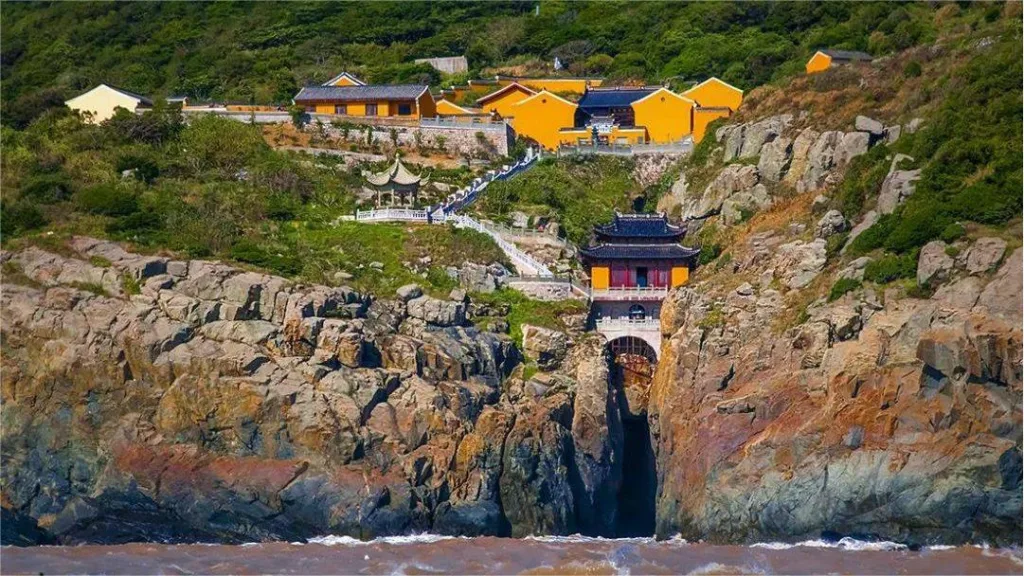Puji Temple (普济寺, Puji Zen Temple), also known as Qiansi (the Front Temple), is located on the southern slope of Lingjiu Peak at Baihua Ding in Putuo District, Zhoushan City. The temple was originally established in the second year of the Zhenming era during the Later Liang Dynasty (916 AD). In the 38th year of Emperor Kangxi’s reign (1699), it was rebuilt and named Huguo Yongshou Puji Zen Temple, receiving the honorary title “Puji Qunling,” thus becoming known as Puji Temple.
As one of the three major temples on Mount Putuo, Puji Temple covers an area of 37,019 square meters and features traditional north-facing architecture. The temple complex includes 10 halls, 12 towers, 7 pavilions, and 7 verandas, totaling 231 rooms and a building area of 11,400 square meters. The temple is designed along a central axis, extending from south to north, with significant ancient structures such as the Imperial Tablet Hall, the Hall of Heavenly Kings, the Hall of Guanyin (Yuantong Hall), and the Sutra Library.
The main gate of the temple, which is a five-bay, double-eaved hip-and-gable roof structure, usually remains closed. Monks and visitors typically enter and exit through the East Gate. When monks pass away, their bodies are traditionally carried out through the West Gate.
The layout of Puji Temple reflects the traditional Chinese architectural style with its central axis design, while also making full use of the terrain for the placement of individual buildings. This design showcases the unique architectural style of the Qing Dynasty and represents a typical example of official architecture from that period in Zhejiang Province.
Table of Contents
- Basic Information
- Location and Transportation
- History of Puji Temple
- Highlights of Puji Temple
- Other Attractions on Mount Putuo
Basic Information
| Estimated Length of Tour | 1 – 2 hours |
| Ticket Price | 5 RMB |
| Opening Hours | 5.30 – 21.00 |
| Telephone Number | 0086-0512-53251396 |
Location and Transportation
Puji Temple is located at the southern foothills of Lingjiu Peak on Baihua Peak in Putuo District, Zhoushan City, Zhejiang Province. The specific address is 15 Xianghua Street, within Mount Putuo. To reach Puji Temple:
- From the Zhengshanmen Pier or parking lots along the way, take Tourist Bus Route 1 to the Xitian Ferry Station. The fare for the entire journey is 4 yuan.
- From the Zhengshanmen Pier or parking lots along the way, take Tourist Bus Routes 2 or 3 to the Baibusha Parking Lot. The fare for the entire journey is 6 yuan.
History of Puji Temple
Puji Temple, originally known as the “Reluctant Guanyin Temple,” has its origins dating back to the Tang Dynasty during the Dazhong era (847-859 AD). The temple’s inception is tied to a Japanese monk named Hui’e, who sought to bring a Guanyin statue from Mount Wutai back to Japan. However, due to adverse weather conditions, he was unable to set sail and subsequently, with the help of a local villager named Zhang, established a temple in the Chaoyin Cave to enshrine the statue.
During the Later Liang Dynasty (915-920 AD), the temple expanded and was relocated to its present site, although some believe the original “Reluctant Guanyin Temple” was established at the current location from the beginning. In the Song Dynasty, the temple underwent several name changes, first to “Wutai Yuan Guang Temple” and later to “Baotuo Guanyin Temple,” as its reputation and the number of worshippers grew.
In the 7th year of the Jiading era of the Song Dynasty (1214 AD), the emperor bestowed a plaque inscribed with “Yuanyong Baodian” (Perfect Penetration Hall), solidifying its status as a dedicated site for Guanyin worship. However, in the 19th year of the Hongwu era of the Ming Dynasty (1421 AD), a policy of maritime prohibition led to the temple’s destruction, and the monks were relocated to Qixin Temple in Mingzhou (modern-day Qita Temple in Ningbo). It wasn’t until the first year of the Hongzhi era (1488 AD) during the reign of Emperor Xiaozong of the Ming Dynasty that the temple was restored to its original site.
The temple faced further devastation during the Jiajing era (1522-1566 AD) of the Ming Dynasty when temples on Mount Putuo, including Baotuo Guanyin Temple, were destroyed once again. In the 33rd year of the Wanli era (1605 AD), the imperial court dispatched the eunuch Zhang Qian to oversee the expansion of Baotuo Guanyin Temple. Located at the base of Lingjiu Peak, the temple was renamed “Huguo Yongshou Putuo Chan Temple,” gaining significant prestige throughout southeastern China.
Despite its growing prominence, the temple suffered another major setback in the 8th year of the Kangxi era (1669 AD) during the Qing Dynasty when Dutch colonial forces invaded Mount Putuo, burning down all buildings except the main hall. The temple was subsequently rebuilt and expanded in the 38th year of the Kangxi era (1699 AD), receiving the new name “Puji Qunling,” and officially became known as “Puji Zen Temple.”
Further expansions took place in the 9th year of the Yongzheng era (1731 AD) during the Qing Dynasty, leading to an unprecedented scale and grandeur. Puji Temple, as it stands today, is a testament to its rich historical legacy, architectural significance, and enduring spiritual importance.
Highlights of Puji Temple
Stone Archway

Visitors usually enter Puji Temple through a grand Stone Archway, which stands approximately 20 meters tall with a four-column, three-gate structure. The archway is adorned with intricate carvings of cloud patterns and stone gourds on the pillars and crossbeams. On the northern side of the archway, there is an inscribed stone tablet that reads, “All civil and military officials, soldiers, and common people must dismount here.” This inscription is said to be an imperial decree, signifying that civil officials should dismount from their sedan chairs and military officers from their horses as a gesture of respect towards Guanyin Bodhisattva.
Imperial Stele Pavilion

The Imperial Stele Pavilion, covering an area of 156.17 square meters, is a five-bay-wide structure topped with a double-eaved hip-and-gable roof covered with yellow glazed tiles. The central bays feature six-panel lattice doors with intricate plum blossom patterns, while the side bays have similar lattice windows. Inside the pavilion, visitors will find three imperial steles from the Ming and Qing dynasties. The central stele, mounted on a 3.5-ton stone tortoise known as a bixi, details the historical evolution of Puji Temple. The bixi is particularly notable for its lifelike design, with a head raised and neck extended, and its eyes capable of rotation.
Heavenly Kings Hall

The Heavenly Kings Hall, also known as the Vajra Hall, is a grand structure with five bays and a total area of 433.97 square meters. The hall features a double-eaved hip-and-gable roof covered with gray tube tiles. The central bay has two panel doors at the front and rear, while the side bays have lattice windows, and the end bays are walled.
Upon entering, visitors are greeted by a statue of Maitreya Buddha, depicted with a bald head, smiling face, exposed chest, and seated posture, holding a cloth bag in one hand. This image symbolizes his ability to contain all the sufferings of the world within his bag. Flanking the statue is a couplet that reads: “慈颜含笑笑天下之可笑之人,大腹可容容世间之难容之事” This translates to, “With a compassionate smile, he laughs at the laughable people in the world; with a big belly, he can tolerate the intolerable things of the world,” encouraging people to be compassionate, tolerant, and maintain an optimistic attitude toward life.
Behind Maitreya stands a statue of Skanda, a guardian deity, depicted with a determined expression and holding a staff. Skanda is believed to be the chief of celestial guards, often patrolling the three continents (East, South, and West) and protecting Buddhist monasteries. On either side of the hall stand the Four Heavenly Kings, who are considered protectors of the Buddha’s teachings. Each king is armed with a unique implement representing their domain – East, South, West, and North. The hall’s courtyard is adorned with eight camphor trees, with diameters ranging from 0.8 to over 2 meters, their dense foliage providing ample shade.
Yuantong Hall

The Yuantong Hall is the main hall of Puji Temple, equivalent to the Mahavira Hall in other Buddhist temples. Named after Guanyin Bodhisattva, also known as Avalokiteshvara, this hall serves as a major place of worship for her devotees. The hall spans seven bays in width and six bays in depth, covering an area of 964 square meters. It features a double-eaved hip-and-gable roof with yellow glazed tiles, and intricate nine-stepped dougong (bracket sets). The door panels are ornately carved with dragons playing with pearls.
Inside the hall, the centerpiece is a seated statue of Guanyin, measuring 8.8 meters in height (the statue itself is 6.5 meters, and the pedestal is 2.3 meters). The statue is gilded in gold, with a serene and compassionate expression, flanked by her attendants, Sudhana and the Dragon Girl.
The east and west walls of the hall feature 16 statues of bodhisattvas in various attire and poses, representing the 32 manifestations of Guanyin, who appears in different forms to guide sentient beings. Including the central statue, there are 33 manifestations of Guanyin in total. The main hall is flanked by auxiliary halls: the Manjusri Hall on the east, dedicated to Manjusri Bodhisattva of Mount Wutai, and the Samantabhadra Hall on the west, dedicated to Samantabhadra Bodhisattva of Mount Emei. Along the side corridors are the Arhat Halls, housing a total of 18 arhat statues.
Bell and Drum Towers

The Bell and Drum Towers of Puji Temple, situated on the eastern side of the temple’s main gate, are exemplary structures of traditional Chinese architecture, featuring double-eaved hip-and-gable roofs. The Bell Tower houses a large bronze bell weighing over 3500 kilograms, cast in the twelfth year of the Jiaqing reign during the Qing Dynasty (1807). Adjacent to it is the Drum Tower, built in a similar architectural style. Every morning and evening, the bell and drum resonate throughout the temple grounds, summoning monks to participate in various activities, echoing scenes depicted in ancient literature as “morning bell and evening drum.” These towers symbolize the rhythmic passage of time and serve as a reminder of the temple’s longstanding traditions and spiritual practices.







